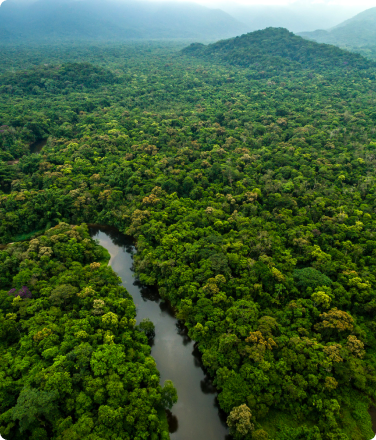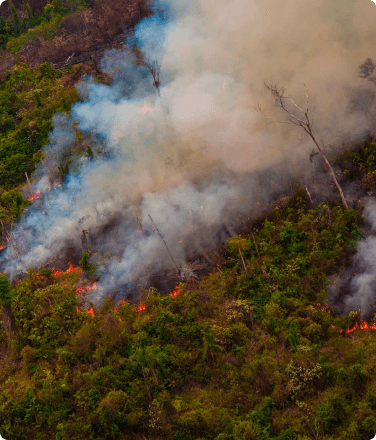The Javari Valley is one of the largest Indigenous territories in the Brazilian Amazon.
IMAGE CREDIT: Bruno Kelly/Amazônia Real
- Indigenous peoples’ lands in the Amazon are effective carbon sinks, absorbing more carbon than they release.
- Lands legally held or titled to Indigenous peoples have lower deforestation rates than untitled Indigenous lands.
- Rainforest Foundation US’s work integrates scientific evidence, technology, and Indigenous knowledge to effectively protect rainforests and tackle the climate crisis.
Indigenous peoples have shaped and managed vast rainforest territories for millennia. These rainforests regulate rainfall, store carbon, and shelter immense biodiversity and sociocultural diversity. In recent years, several studies have provided statistical evidence confirming that lands legally titled to Indigenous peoples are the most efficient models for forest protection.
Forests Managed by Indigenous Peoples Capture More Carbon

A separate report [2] from 2023 indicates a positive advancement in formal recognition of Indigenous, Afro-descendant, and local communities’ lands, with an increase of 102.9 million hectares (254 million acres) between 2015 and 2020. This news was well received by Rainforest Foundation US (RFUS). As one of a handful of global organizations that directly support Indigenous communities to gain title for their customary lands, we understand the effort involved in landback initiatives. This data underscores that community advocacy efforts are working; these communities now hold more than 11% of the Earth’s terrestrial land of the 73 countries analyzed in the report—covering 85% of global land.
However, these gains are not without their challenges, and there is a long way to go. The same report notes that at least 1.3 billion hectares (approximately 3.2 billion acres) of ancestral lands remain unrecognized under national laws, leaving them vulnerable to exploitation and degradation. Moreover, as many countries in the Global South push for speedy economic and industrial development, the demand for land—including Indigenous peoples’ territories—intensifies.
Land Rights Are Crucial to Halt Deforestation
The critical role of Indigenous communities holding land titles was underscored in another peer-reviewed study [3] from 2020 focused specifically on the Brazilian Amazon. By examining data from 245 Indigenous territories ratified between 1982 and 2016, researchers found that deforestation significantly decreases within these territories once they are legally recognized. Communities with established collective property rights have legal backing to protect their lands against the unauthorized exploitation of resources, leading to an approximate 66% decrease in border deforestation, the study showed.
Another report [4], published in 2023, also indicated a heightened capacity for the restoration of deforested lands in titled Indigenous territories. Over a 33-year span, these areas experienced a 5% increase in secondary forest coverage, marking a 23% greater growth compared to adjacent, privately owned, or unincorporated lands.
Technology Can Bolster Indigenous-Led Rainforest Protection

A Rainforest Foundation US analysis, published in 2021 in the Proceedings of the National Academy of Sciences (PNAS), found that communities equipped with satellite data via smartphones saw dramatically less forest loss than similar communities that did not adopt the technology. Between 2018 and 2019, researchers implemented technology-based forest-monitoring programs in 36 communities in Loreto, the northernmost region of the Peruvian Amazon. They trained and paid three representatives from each community to patrol their forests monthly and verify reports of suspected deforestation using a smartphone application and satellite data. Compared with 37 other communities in Loreto where the program wasn’t implemented, those under the program saw 52% and 21% less deforestation in 2018 and 2019, respectively. The gains were concentrated in communities at highest risk of deforestation due to threats like illegal mining, logging, and the planting of illicit crops such as coca to manufacture cocaine, the researchers found. In fact, this RFUS supported monitoring program in Peru and elsewhere resulted in 13.7 million acres protected in 2023 alone.
The important takeaway in these findings lies in the contribution of Indigenous and community-managed lands to mitigating climate change and biodiversity conservation. Expanding land rights is pivotal for environmental protection efforts, stressing the need for policies and support to secure Indigenous and community land management and ownership as a critical step toward achieving global climate and biodiversity targets. Integrating Indigenous peoples’ territories into conservation strategies, increasing government support for Indigenous land management, and ensuring a greater portion of climate finance reaches Indigenous communities directly are all essential and urgent acts, and are core to Rainforest Foundation US’s work.
Notes
- [1] World Resources Institute (WRI): Indigenous Forests Are Some of the Amazon’s Last Carbon Sinks. 2023
- [2] Rights and Resources Initiative (RRI). A Global Baseline of Carbon Storage in Collective Lands. Indigenous And Local Community Contributions To Climate Change Mitigation. 2023
- [3] The Proceedings of the National Academy of Sciences (PNAS): Collective property rights reduce deforestation in the Brazilian Amazon. 2020
- [4] The Proceedings of the National Academy of Sciences (PNAS): Collective property rights lead to secondary forest growth in the Brazilian Amazon. 2023
- [5] The Proceedings of the National Academy of Sciences (PNAS): Satellite-based deforestation alerts with training and incentives for patrolling facilitate community monitoring in the Peruvian Amazon. 2021








